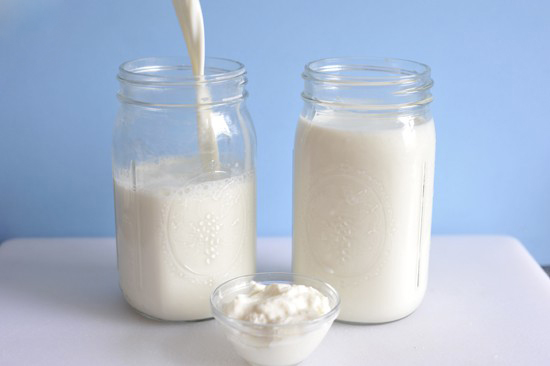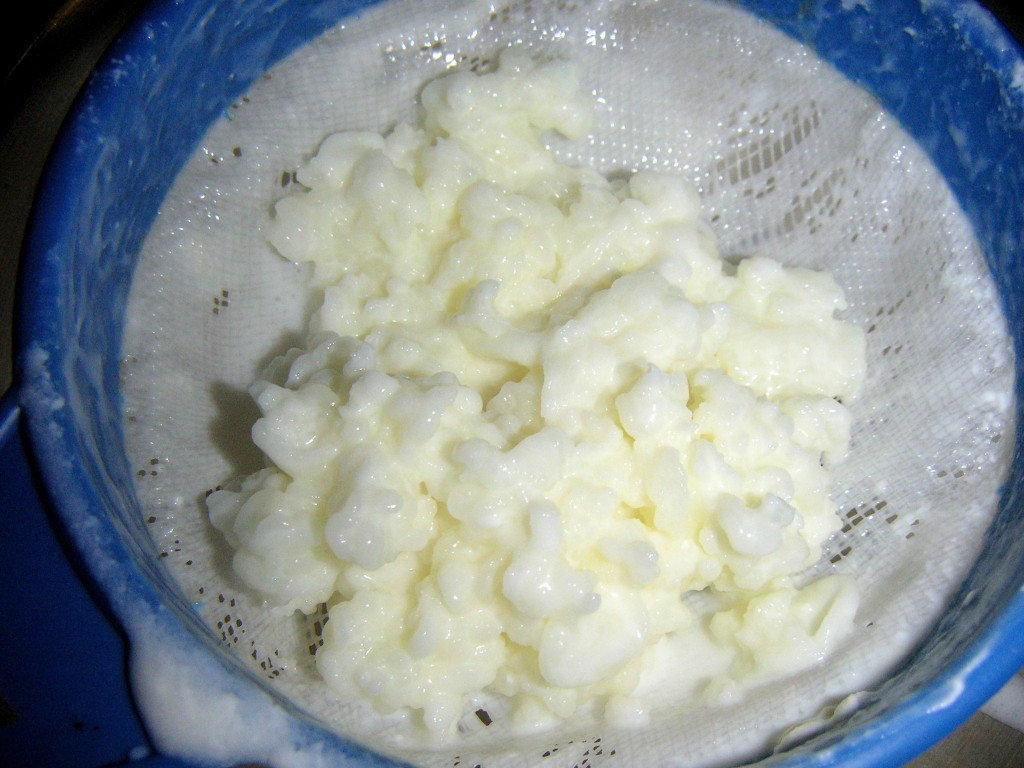 I personally love the tangy, fresh flavor of coconut milk kefir—not so my son who thinks I’m being quite kind with those adjectives but I do think that is because he first tried store bought cow milk kefir which to me most certainly has a strong fermented, sour flavor.
I personally love the tangy, fresh flavor of coconut milk kefir—not so my son who thinks I’m being quite kind with those adjectives but I do think that is because he first tried store bought cow milk kefir which to me most certainly has a strong fermented, sour flavor.
Buy good kefir grains here. (Comes with a cage to easily reuse them)
(Note: you use about 1-2 tablespoons kefir grains in a quart jar of fluids–the picture below shows *lots* more grains than you will ever have/need)
Coconut milk kefir is pleasantly tangy, but the naturally sweet taste of coconut dominates. The texture is smooth, rich and thinner than yogurt. Both the flavor and texture of homemade kefir is superior to any store-bought coconut milk kefir we’ve tried.
Why drink coconut milk kefir? Loads of healthy probiotics. In fact, healthy grains will have nearly 300 different probiotic bacteria and yeast (yes, there are probiotic yeasts).
Although Kombucha and cow-milk-based kefirs (pronounced Keh-FEAR) have become popular in the grocery isle, these are costly and not as healthful as their wrapper and “the buzz” may lead you to believe. The main problem is they are loaded with sugars and flavors and the poor quality of commercial milk…
 And the cost! make your own highly beneficial, dairy-free, sugar-free, probiotic beverage by making coconut milk kefir.
And the cost! make your own highly beneficial, dairy-free, sugar-free, probiotic beverage by making coconut milk kefir.
Besides, coconut milk itself is a great source of calcium and healthy fats and is low in sugar.
This is a simple recipe and very very inexpensive to make—much less costly than buying commercial beverages that may not be as good for you or taking probiotics in capsule form.
What are the benefits of coconut kefir?
- We have ten times more bacteria in our gut than cells in our body. Creating an optimal environment for bacterial balance is vital to gut health. Poor bacterial balance can cause blood sugar imbalances, sugar cravings, weight gain, poor immunity, low energy and digestive disturbances.
- Coconut is very healing to your digestive system and liver.
- Regularly drinking coconut milk kefir can help relieve intestinal disorders, promote bowel movement, cleanse the endocrine system, reduce flatulence and create a healthier digestive system.
- Adding probiotic foods to your digestive helps your immune system—healthy bacteria and yeast help kill of unwanted pathogens.
- Coconut milk kefir made from grains at home has a high concentration and wide variety of microflora—much more than commercial yogurt. Followers claim it has a much more potent effect on the digestive system than any yogurt
- Kefir also contains beneficial yeasts that are known to hunt out and destroy pathogenic yeasts in the body. Considered the best defense against Candida, beneficial yeasts clean, purify and strengthen the intestinal walls which also helps you resist pathogens such as salmonella and intestinal parasites.
- Kefir consumption is associated with reduce risk of cancer.
- The lactic acid bacteria in kefir appear to block cholesterol re-absorption and lower blood cholesterol.
- The beneficial micro-organisms in kefir also make important nutrients and help you assimilate them, especially proteins, healthy fats, and B vitamins.
Serves 2-8
Ingredients
1 tablespoon of kefir grains
1 14 oz can of coconut milk —warmed or blended so there are no lumps
(Optional) unsweetened (!!!) almond milk if the coconut milk is too thick for your tastes
Preparation
If you haven’t made kefir before you’ll first need to acquire some kefir grains. The least expensive option is to try to get extra grains from someone who’s already making kefir. Can check with local members of your Weston A. Price Foundation. Healthy kefir grains multiply; people who regularly make kefir often have extra grains to share with others.
If you can’t find any free grains locally you can also order grains online. I highly recommend this online source for quality kefir grains. If you use this resource, SKIP this next step because the kefir grains are not dehydrated—they arrive ready to go (if sleepy). For now, they still are “waking up” so use the amounts below.
Note: Most grains are grown in cow milk. Switch them to the non-dairy “milk” of your choice by “rinsing” them first: put them in about an inch of coconut milk to start, let them sit a few hours then pour off the liquid through a sieve, or cage, or even a cheesecloth bag to retain your grains. Then follow the “making kefir” instructions.
How to rejuvenate dehydrated kefir grains: (most online sources send them dehydrated) then follow the instructions you’ll receive: usually you first re-hydrate kefir grains in a cup of cows’ milk. Set this out at room temperature in a loosely covered glass container. Each day, for 5-7 days, strain the grains out and then place them in a fresh cup of milk. When the batches of milk take on a slight fermented smell and thicken, your grains are ready.
Making Kefir
- Combine the kefir grains with coconut milk in a 1 quart glass container (canning jar…).
- Loosely place on the jar lid (or a cloth with a rubber band) and let sit in a warm place (68-85 degrees) for 12-24 hours. Once the coconut milk has thickened or you can see the clear whey forming / separating out, and it has a slightly sour flavor, it has turned into kefir.
- That’s it! Strain through a plastic strainer, or otherwise remove the grain cage, refrigerate the kefir and and enjoy!
- Plan to re-use the grains!! Start a new batch of kefir right away or store the grains in a cup of cows’ milk in the refrigerator.
Helpful Kefir Tips
- Kefir is done when you can visibly see the clear “whey” separate from the creamier, thicker “curds.” This can take varying amounts of time depending on the warmth of the room and the activity of your kefir grains. Don’t let them sit too much longer after this, they are running out of food. A few hours is fine, a whole day would not kill them but might slow them down for your next batch.
- If your first batch of coconut milk kefir doesn’t get as thick or tangy as you’d like, don’t despair. It can sometimes take a few batches to acclimate the kefir grains to coconut milk. Start with the volume of “milk” in the instructions, above. After a few days you can make a whole quart from a tablespoon of kefir grains and I often mix the thicker coconut milk with thinner unsweetened almond milk.
- Never use a metal container to make kefir – this disrupts the process and the kefir won’t thicken. Use glass containers (canning jars work well) and stir with a wood or plastic spoon rather than metal.
- If your kefir doesn’t begin thicken within 24 hours, it might not be warm enough where you have set them. Kefir grains like warmth.
- If your kefir hasn’t thickened at all within 48 hours, throw out the milk and start over by putting the grains in a fresh batch of milk.
- Kefir should have a fermented aroma and can sometimes have a slight effervescence, but it shouldn’t smell foul or unpleasant.
- Kefir grains often multiply quickly. If you find yourself with extra grains, give them away to friends, eat them as extra probiotics, or just throw them away in your trash or compost.
- Kefir grains can be used indefinitely to make kefir, however, if they have been stored it may take a few batches to get them going again. Recommend you store grains for no longer than a week before providing them with fresh milk.
I recommend making a small batch of kefir—about what you will drink every day or two—rather than making a large batch and then storing the grains in the fridge. Kefir grains thrive best when they are allowed to spend most of their time culturing on the counter. - The grains don’t store well in coconut milk. If you aren’t going to make kefir for a bit , store them in cows’ milk. (you can also return them to cow’s milk if you feel the grains have “slowed down”)I recommend making a small batch of kefir—about what you will drink every day or two—rather than making a large batch and then storing the grains in the fridge. Kefir grains thrive best when they are allowed to spend most of their time culturing on the counter.
De Oliveira, L et al. (2013). Microbiological, technological and therapeutic properties of kefir:Â a natural probiotic beverage. Braz J Microbial, 44(2); 341-349.
Copyright © 2014 Marie Sternquist. All Rights Reserved







Thanks Marie for the good information about kefir. I just ordered some of the canned coconut milk you recommended above as I’m frustrated with other coconut milk..too many additives and I’d like to make my own kefir.
I have a question about Yerba Mate. I’ve been drinking the tea for a year or more instead of coffee and I’d like to know the health benefits of Yerba Mate compared to coffee. Do you have such information? Thank you in advance.
Hi Sue – sorry for the delay in answering this. I’m happy to hear you’re adventuring into coconut milk kefir. By now, you’ve made many batches 🙂
Yerba Mate is the dried, crushed leaves and twigs of the rainforest holly tree. It is high in antioxidants giving it the capacity to reduce oxidative stress / free radical damage. Coffee has some antioxidants as well; not as many. Yerba Mate (like green teas), has high amounts of minerals and vitamins (potassium, manganese, phosphorus, sodium, nitrogen, etc., and vitamins A, C, E, etc.). Green teas may be higher even again.
There is some evidence that Yerba Mate acts similarly to green teas in helping sugar balance for type 2 diabetics and improving weight loss. As an antioxidant, it also appears to help with certain nervous system conditions.
Sounds pretty good, eh?
Probably the biggest problem with coffee and even the green teas is how they are grown and harvested. I truly recommend certified organic to avoid the otherwise high pesticides and look for fair trade practices (from what I know, Yerba Mate most definitely adheres to this; I’m speaking more about coffee or tea companies that often do not).
Nice to hear from you 🙂 –Marie
I ordered Kefir grains from the recommended website and they said they won’t work in coconut milk. I’ve had them sitting in the fridge for 3 months (in milk) – no idea how to get them to work in coconut milk. I’ve been dairy free almost 10 yrs and I’ve been buying kefir at the farmers market, but really want to make my own. Should I rinse the grains I have and try them in coconut milk? I’m thinking it might take a couple “ferments” to purge the milk proteins and get them active. I’ve read your steps and want to really give this a try.
Hi Melissa, They do work. I’ve kept mine for at least six months in coconut milk and they happily make kefir that whole time. If unsure, give them a rest in cow milk periodically. I’ve contacted the vendor to let them know it works great; think they are just avoiding complaints and I truly understand their hesitation.
I have been drinking cows milk kefir I make at home. Tastes delicious and I always second ferment. I am a diabetic. My blood sugar goes up 30 points after drinking the milk kefir. I want to switch to coconut milk kefir and cant find anywhere on searches if coconut milk kefir has as many and as good quality probiotics as cows milk kefir. Amazingingly hard to find this information. I have SO DELICIOUS BRAND half gallon coconut milk but the label says it has zero sugar. I concerned that without sugar the probiotic content wont be as good as cows milk kefir. I am guessing that the grains still ferment and add the good bacteria to the coconut milk for awhile and then need reintroduction to cows milk. That extra step would be fine with me . Just want to be sure the same beneficial probiotics are in the coconut milk kefir or close to whats in the cows milk kefir. Thanks?
Hi Joseph, This is a really good question–especially because the vendors of quality kefir grains provide specific instructions only for cow milk kefir. And if you ask them about making coconut milk kefir instead, they caution you that it doesn’t work. But I routinely buy grains from the vendor link on this post as they are very high quality and routinely use them to make coconut milk kefir for months without returning the grains to cow milk for “refreshing.” I’ve never seen them run out of steam… but I do travel much for clinical reasearch so I do give my faithful kefir grains away and then just get more when I return home–longest I’ve personally re-used them is 6 months and I gave those away; last I heard they were still working. While I have never had my kefir tested for population of bacterial strains, I’ve seen coconut milk kefir help reinoculate the digestive tracts of severely imbalanced clients so I am assuming it comes close to the milk version and is still far more diverse than store-bought yogurt or probiotic supplements that are usually limited to just a couple of strains. You are correct, fermentation specifically involves the sugar content–of which coconut has or should have some coconut sugars, 5 grams per cup of milk expressed from the coconut meat. Do note also that probiotics will also “feed” on the soluble fibers and fats, although technically speaking this is not fermentation.
Two important other things:
The type and brand of coconut milk is important. Good for you for steering away from the cane-sugar-added boxed brands but I’ve found those thinner “milk substitutes” to not support the kefir grains very well. They also have a lot of additives and those can work against you depending on your health situation. My favorite brand is Native Forest using BPA-free cans and with just one additive–guar gum, a soluble fiber (meaning it dissolves in water and, therefore, is usually changed by the probiotics living in our gut during our digestive process) from the guar bean, or Indian cluster bean, which grows primarily in India and Pakistan and has been extensively tested for its safety in people. As a note, that extensive research shows that because guar gum slows down sugar transport out of the small intestine, more sugar remains in the food as it transits to your colon and, therefore, people with IBS or Crohn or various of the colon bacterial overgrowths should not have anything with this additive until/unless they have monitored it as an addition to their “safe” food list found via an elimination diet–contact me at marie@successhealthcoach if your concerns include this and you need some help getting to the bottom of you dietary influences. Otherwise, that link goes to a vendor that has the best price per can I’ve ever seen. You can also make your own if so inclined (I’ve not yet ventured into making coconut milk so cannot reliably provide instructions but I’ve heard it is nowhere as hard as I’m making it out to be in my head ;-). Not sure the boxed brands will do what you want.
Also, while reinoculating your digestive tract is important, your routine diet has to foster and maintain the bacteria you want to keep. In other words, coconut or any milk kefir is not going to solve a problem of too many sugary/starchy/bready/grainy foods that likely contributed to the disruption of gut imbalance in the first place. These symbiotes need to have plenty of plant fibers and healthy non-inflammatory fats to maintain themselves once in your gut. Just being thorough with my answer 🙂
Enjoy your day and thanks for giving me an opportunity to share information. Best, Marie
I found freeze-dried Kefir starter, yogourmet brand, at natural pantry. Is that the same as starter grains?
Also, how does the process of starter grains being stored in cows milk but made with coconut milk affect those with a dairy allergy?
Thanks for your help!
Hi Wendy! Really great question. Kefir grains and the freeze-dried starter products are two very different things. Two important differences:
1. Kefir grains are reusable, you strain the kefir from the grains and then add new “milk” restarting the process using the same grains over and over and over… the freeze-dried packets are 1X use.
2. the freeze-dried packets don’t have as diverse a population of probiotics as the living grains.
That said, the freeze-dried packets can be simpler. The grains are like having a pet; you have to feed them and keep them nourished. But if you want a regular source of kefir then the grains are definitely the cost-effetive and nutritional way to go.
I get my grains and strainers here: and I just start them right up in coconut milk skipping over the vendor-recommended storage in cow milk. It works just fine. Good luck!
Marie